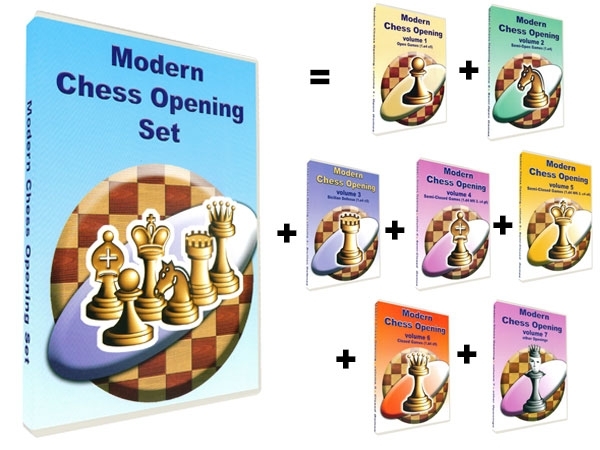Improvement for experienced intermediate players (1600 – 2000 Elo)
Improvement Guide Articles
Here are some articles by GM Alexandra Kosteniuk and chess guru Steve Lopez on how best to improve at chess from different levels. You can come back to this main page anytime.You’ve reached a level at which you’ve learned much, and you’ve put that chess knowledge to good use. If you’re a chess club member you’ve improved to a level that places you solidly in the middle of the pack. While not a top rank player, you’ve certainly reached a level of recognizable competence. It’s time now to expand on that knowledge to rise even higher in the ranks of non-titled players.
Your checkmate studies should now include longer and more complex mate combinations; you should be regularly solving three to four move mates of some complexity. The tactical exercises on which you’re working should also be more complex, with complex deflections, interferences, and decoy maneuvers being a part of your daily regimen.
The program of endgame studies you undertake should now include minor piece endings in addition to more advanced major piece and pure pawn endings. The strategic themes you study should likewise become more difficult and complex, with a particular emphasis on structures and strategies involving pawns. (The link between structure, strategy, tactics, and endgames should also start becoming more clear to you, with these links strengthening in your mind over time; for example, learning about middlegame pawn structures will help you anticipate and properly execute pawn endings, including understanding the timing of when it would be beneficial to trade pieces to bring on said endgame).
You shouldn’t neglect the openings either; you should be solidifying your knowledge of the ideas behind specific openings, as well as learning how they relate to individual opening variations.
Defensive techniques should also be a part of your study program, and should include more complex motifs than those you studied as a lower-level intermediate player.
You should definitely be having a computer program analyze your games, with a particular emphasis on games you’ve lost against human opponents. Since it’s often not possible (due to time constraints) to have your chess software program analyze all of your games, you should be selective about which of your games to analyze; it’s best to choose losses against human players, as your losses will be more instructive than your victories, and analyzing games against humans will also show you how you could have exploited your opponent’s mistakes.
It’s also worthwhile at this stage to invest in a good computer chess database program, one which gives you a great amount of flexibility when devising your search parameters. A good database program will allow you to access games using a large set of variables; for example, if you play a particular opening frequently and often find yourself at a disadvantage in certain endgames, you should be able to search a database of millions of games to find (and replay) games using that opening and endgame (such as pure pawn endings arising from the Ruy Lopez Exchange Variation).
After you’ve reached 1800 Elo you’ll be studying more advanced principles. You’ll work on first spotting and then devising multi-move combinations (both material-winning tactical sequences and complex mates). You’ll also be learning about advanced strategic principles and maneuvers, analyzing piece positions and pawn structures to create plans, and increasing your opening and endgame knowledge.
Several of the training courses described in the previous section will still be appropriate and instructional at your present level of play. These include Chess Combination Encyclopedia, Chess Tactics Level III, Mating Combinations, Opening Lab, and CT-ART 4.0.
The tactical combinations you’ll concentrate on will be more complex than at lower levels, and Chess Tactics for Club Players will give you plenty of exercises on which to flex your tactical muscles:

The course contains 230 tutorial examples to teach you the concepts, as well as 1,200 exercises on which to test your skills. The exercises are organized by tactical theme, but can be randomized for an even greater challenge (as you’ll not know the theme beforehand).
Your strategic studies should begin with Chess Guide for Club Players:

This training program consists of 75 lessons which include over 400 examples derived from top players’ games. You can then practice what you’ve learned with more than 200 exercises, for which Peshka will track your progress and provide a rating based on how well you’ve done.
As mentioned above, your endgame training should now be covering all types of endings. That’s where Total Chess Endings will prove itself invaluable as a training aid:

Total Chess Endings provides you with more than 700 instructional examples which clearly explain the principles behind the chess endgame, as well as 2,450 challenging endgame exercises organized according to 500 themes. When using the course in Peshka you’ll be able to randomize the chess problems if you wish so as to not know beforehand the theme which is involved in the solution.
Your opening training should now be moving toward the ideas of individual opening variations. You can acquire the knowledge you need to properly play the openings though the seven volume Modern Chess Opening collection:

The seven individual volumes each contain hundreds of theoretical discussions regarding individual opening variations: Open Games, Semi-Open Games, Sicilian Defense, Closed Games, Semi-Closed Games (two volumes), and Other Openings. You can choose to specialize in a few specific types of openings or use the complete seven volume set to have a complete opening encyclopedia at your fingertips.
Likewise, the ten volume Chess Tactics in the Opening illustrates how winning tactical opportunities are often available to an alert player even at an early stage in the game:

The ten volumes include tactical instruction in the French Defense, Slav Defense, Sicilian Defense (two volumes), Open Games, King’s Indian Defense, Gruenfeld Defense, Caro-Kann Defense, Benko Gambit, and Scandinavian Defense. The typical volume of the set features 200 to 300 instructional examples and 300 to 500 practical exercises for you to solve. As with the Modern Chess Opening collection, you can specialize in a specific opening or practice using the entire set to become a tactical master in nearly any opening.
After reaching the 1800 Elo level, you should continue your strategic studies. Chess Guide for Intermediate Players will expand your strategic vision:

The 75 lessons in this study course will provide you with the tools you need to understand chess strategy, helping you to create effective plans and long-term goals in your games. The lessons provide 290 informative instructional examples which will aid you in solving the more than 750 exercises given to test your skills.
As previously mentioned, reaching the 1600 to 2000 Elo level is an ideal time to acquire a good chess database program. Chess Assistant is the perfect combination of utility and affordability:

Chess Assistant Pro allows you to play chess online and against a computer, analyze your games, and have easy access to a database of more than six million games, fully searchable by a wide variety of criteria, including game header information, board position, piece arrangement, pawn structures, openings, endgame material, and more. You can supplement the lessons provided in your chess courses quickly and easily by finding additional relevant games in Chess Assistant’s massive database, and then replay the games on your onscreen electronic chessboard. It’s like having a gigantic chess library on your computer.































